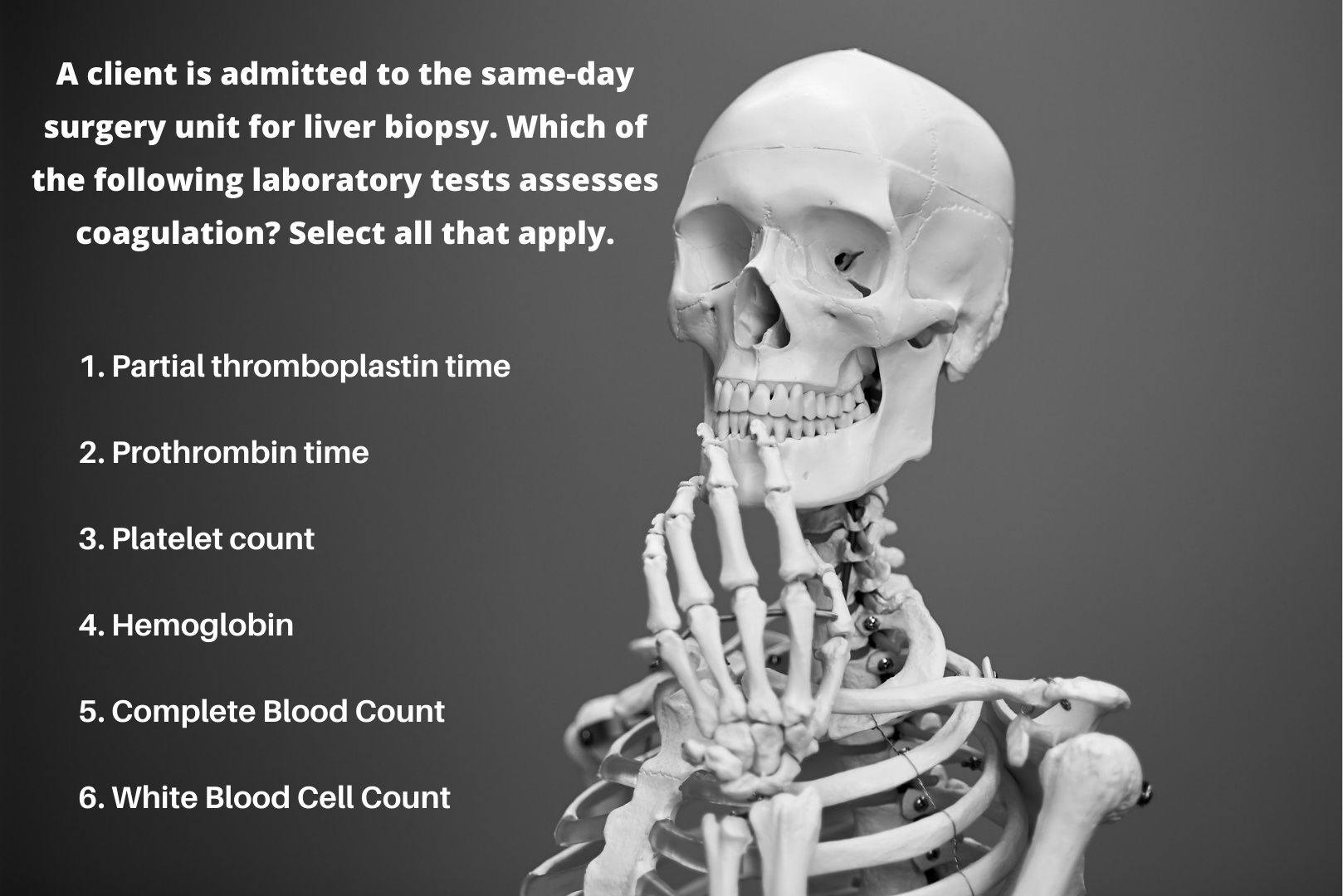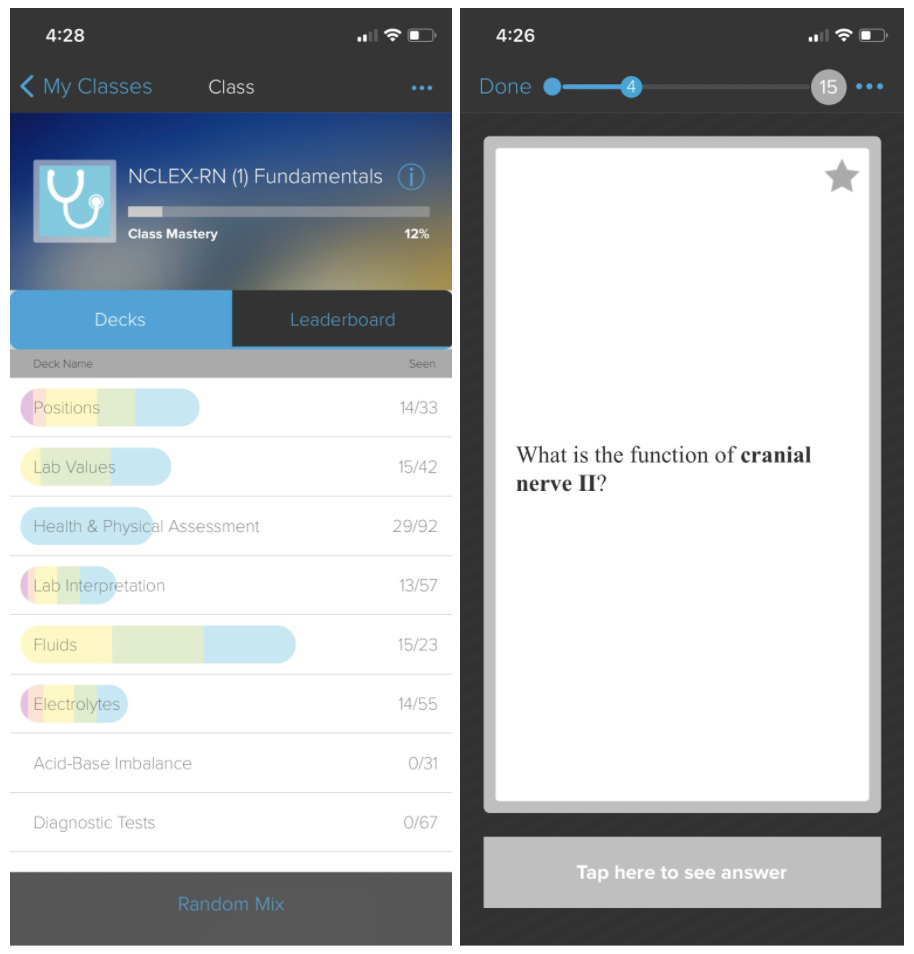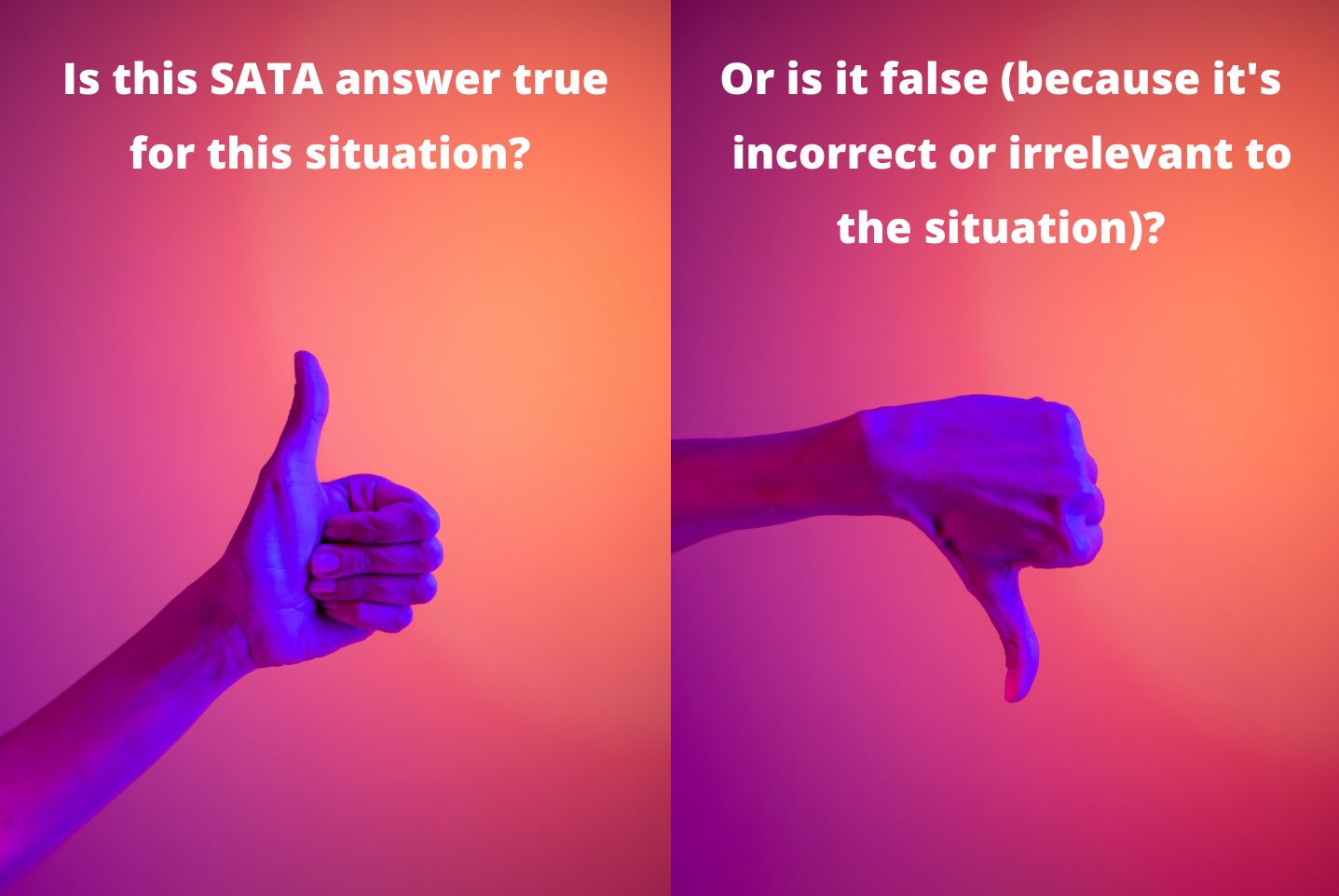One of the most dreaded parts of the NCLEX is the ‘select all that apply’ (SATA) questions. With multiple possible answers, SATA questions can feel to students like a game of Russian roulette.
But fear not! Brainscape has got some excellent strategies to answer NCLEX ‘select all that apply’ questions thanks in no small part to Justine Buick—our qualified Registered Nurse consultant and The NCLEX Tutor.
Justine has been teaching nursing students how to pass the NCLEX for many years, so she knows all the test-taking strategies necessary to do well in this high-stakes exam.
Together, we have created this guide, as well as certified flashcards for the NCLEX. (These 3,000 flashcards contain the most important facts distilled down into question-and-answer pairs, which you can practice via the engaging Brainscape app.)
In the next few minutes, we’ll be showing you bulletproof strategies for tackling the NCLEX ‘select all that apply’ questions, without the guesswork. Once you’ve learned to apply these NCLEX test-taking strategies, answering SATA questions will go from being a stressful crapshoot to something you excel at, and therefore, kinda look forward to on the exam! (Yes, it’s quite possible.)
So let’s kick off with a look at the anatomy of NCLEX ‘select all that apply’ questions and why so many students get them wrong ...
What we cover in this NCLEX study guide:
- The anatomy of NCLEX SATA questions
- Why do many students get SATA questions wrong?
- Tips for winning at NCLEX ‘select all that apply’ questions
- NCLEX ‘select all that apply’ practice questions
- NCLEX SATA: Your mental checklist
Oh, and don't forget to get your free NCLEX study planners and exam countdown sheets, which you can customize however you want to stay hyper focused and on track to crush your study goals!
The anatomy of NCLEX SATA questions

SATA questions are Multiple Response Items, which means that you need to select every correct answer from a list of many possible answer options. It’s like multiple-choice questions but with at least one, and often more than one, correct answer. (Make sure you familiarize yourself with the changes introduced by Next Generation NCLEX!)
For example: The nurse teaches the mother of a newborn that in order to prevent sudden infant death syndrome (SIDS) the best position to place the baby after nursing is? Select all that apply.
- Prone
- Side-lying
- Supine
- Fowler’s
- Trendelenburg
The answer is 2. Side-lying and 3. Supine.
What makes NCLEX ‘select all that apply’ questions even trickier is that if you don’t select every correct possible answer—it may be one, it may be most of them—you’ll get penalized.
Thankfully, with the introduction of Next Gen NCLEX on April 1, 2023, you're now (mercifully) awarded partial credit for checking some/most of the correct answers, whereas before, no partial credit was awarded, even if you checked four out of the five (or five out of six) of the possible answers.
(Tip: the correct answer will never feature all of the possible answers. If you do come across a practice question in which all the answers need to be checked, it’s not a good practice question and you should be wary of the source.)
Why do many students get SATA questions wrong?

Well, NCLEX ‘select all that apply’ questions are tricky but aside from their more complex nature, there are other reasons students trip up on SATA questions:
Reason 1: Students find SATA intimidating
So they stick their head in the sand and avoid practicing them, thereby failing to develop any SATA test-taking strategies.
Reason 2: Students approach them as straightforward true/false questions
Running through each possible answer and seeing whether it is “true” or “false” with respect to the question is just one strategy you can apply but not the only one. In fact, applying this blanket approach to all SATA questions can cause you to trip up on certain questions and miss out on valuable marks.
Reason 3: Students get sidetracked by ‘sample of one’ outlier cases:
SATA questions are concerned with the standard of care in certain defined situations. Therefore, the answers you select should reflect the rules and not those rare exceptions you may have heard of or encountered during your clinical experience.
Reason 4: Not really understanding what the question is asking:
This all-too-often comes down to anxiety because the student is in too much of a rush to answer the question to read it properly and understand exactly what problem or situation requires resolution.
Reason 5: There are some poorly written SATA questions out there!
This is just the unfortunate reality. And these poorly-written SATA questions really can and do confuse students. If you think you are correct and the rationale is telling you something different, it's very likely that you are correct and the rationale is WRONG.
Reason 6: An answer sounds good...but is actually wrong
Students oftentimes become persuaded by an answer because it sounds good ... but it isn’t relevant to the particular problem at hand. Perhaps to another closely-related problem ... but not the problem defined in the question.
In the next section, we’ll be addressing all of these common mistakes with Justine, The NCLEX Tutor’s very best advice on how to perform well on the NCLEX ‘select all that apply’ questions. And if you still feeling the sting of NCLEX stress after this advice, we have some super helpful additional reading resources for you to turn to:
- How to manage your NCLEX stress
- How to study for the NCLEX more efficiently
- How to use NCLEX practice questions
Tips for winning at NCLEX ‘select all that apply’ questions

Tip 1: Don’t fear SATA questions
Look, about a third of the NCLEX is made up of SATA questions so you simply cannot afford to be afraid of them. Besides, your fear is most commonly born out of two things: (1) not having mastered all the necessary content and (2) not having the NCLEX test-taking strategies to answer them confidently.
The latter we will be addressing in this guide but the first you can take care of by:
- Studying efficiently for the NCLEX,
- Taking a good NCLEX review course,
- Devoting yourself to the daily review of the course material,
- Answering NCLEX practice questions every day
We also really recommend Brainscape’s certified NCLEX-RN flashcards or NCLEX PN flashcards, which, being accessible as a mobile app, makes it easy for you to tap into your NCLEX studies wherever you go and in whatever snatches of time you have.
We know you can understand the nursing content, but what’s important is that you practice retrieving it when you are getting asked about a variety of topics on the NCLEX.

These flashcards test your understanding of the material in a way that helps you learn it twice as efficiently and effectively as traditional study methods, using key cognitive principles like spaced repetition, metacognition, and active recall.
Want to learn more? Read all about the science of Brainscape and why it is one of the most effective learning tools for knowledge-intensive subjects like the NCLEX.
Tip 2: Understand what the question is asking
The NCLEX essentially tests your ability to solve problems in a healthcare setting, so your first step is to identify the problem or situation requiring resolution.
Read the question very carefully and before you even look at the list of possible answers, ask yourself: “What is the problem here?” or “What exactly is required of me in this situation?”
Once you understand the problem or situation, you can move on to: “What should I do about it?” Then, once you have a solution in mind, look through the SATA’s list of possible answers, and choose the ones that apply directly to the situation.
Remember, the decisions you make as a nurse can have life-changing consequences so don’t rush through the question and risk missing important information.
Tip 3: Pick answers that directly address what the question is asking
Be wary of selecting possible answers that are not immediately necessary, relevant, or specific to the problem or issue you are addressing. As a nurse, your task is to solve problems with expediency and without squandering hospital resources in the process.
As such, the NCLEX ‘select all that apply’ questions are looking for you to provide relevant answers to the specific problem defined in the question. Just because one of those answers sounds like it could be sort-of helpful or at the very least harmless, doesn’t mean it’s right for your question.
For example: An MRI is an important diagnostic tool that provides answers in many healthcare scenarios. But if your client is presenting with severe, flu-like symptoms, it is not one of the first tests you do. Therefore, if one of the SATA answers is to prepare the client for an MRI, you can safely discard that as a possible answer. The correct diagnostic tests would be cultures of the throat, blood, sputum.
This really points back to our first tip: (1) understand what the question is asking, (2) identify the problem or situation, and (3) pick relevant answers that are stepping stones to solving that specific problem.
Tip 4: Don’t get distracted by rare, ‘outlier’ cases

The ‘select all that apply’ questions you’ll answer in the NCLEX exam will be designed to test good, safe nursing care that works for the vast majority of people.
It’s unfortunate that, oftentimes, students will work out the right answer based on nursing best practices, but then become derailed because they once heard of this super rare case in which a client had a weird side effect.
Your knowledge of rare, unusual, extreme, or outlying cases is not going to help you answer these questions correctly. Work instead with what will fit 99% of all clients.
Tip 5: Run possible SATA answers through the true/false filter

One of the most popular NCLEX test-taking strategies for ‘select all that apply’ questions is to run through each potential answer and see whether it is “true” or “false” for the problem you’re trying to solve, or whether you can answer “yes” or “no” to it.
If you can definitively say “this answer is false” or you are compelled to say “no” to it, then you can eliminate that answer. This is a simple way to narrow down your options.
The true/false strategy applies nicely to certain SATA questions, particularly those that ask about symptoms of a disease or side effects of a med. If you know your stuff, it’s easy to say which statement is true or false. However, some SATA questions require a bit more critical thinking to get them right.
The bottom line is: running possible ‘select all that apply’ questions through the “true/false/yes/no” filter is one NCLEX test-taking strategy you can apply but it shouldn’t be the only trick in your toolbox.
Tip 6: Use the phrase: “Would this help, harm, or do nothing?”

Another trick you can use to eliminate (or confirm) possible answers that apply to the question being asked is to ask yourself: “Would this help, harm, or do nothing?”
This is particularly the case when the answer choices are interventions for a client, such as a medication. For example: If I gave the client medication X for the symptoms described upon hospital admission, would it help them? Would it harm them? Or would it do nothing?
If a possible answer yields the “harm” or “do nothing” option, then it’s probably a good idea to discard it. After all, your priority as a healthcare professional is to do no harm (nonmaleficence). And what’s the point of administering medication if it doesn’t do anything?
Tip 7: Notice when two or more answers are CONNECTED
It’s pretty common when working through an NCLEX ‘select all that apply’ question to notice that two (or three) of the possible answers are connected or very similar. Perhaps they have the same outcome or you can’t do one without the other.
What you need to be aware of is selecting one possible answer (which is actually linked to one or two others) and then NOT selecting those one or two others. If you select the one, you should select the others that are linked.
Similarly, if two or more answers are connected or linked and you know for a fact one of them is wrong or irrelevant, you will probably find that the same applies to the others.
This happens A LOT in SATA questions so look out for answers that are CONNECTED or linked.
Tip 8: Notice when two or more answers are CONFLICTING
In a similar way to the above tip, some NCLEX ‘select all that apply’ questions can offer up conflicting answers. For example: hypotension and hypertension are conflicting. You can't choose both at the same time because they are opposites.
Just because you may have been taught to consider each answer individually, you should be wary about choosing two that are opposites or mutually exclusive. Pick one or the other, not both.
Tip 9: Strategies aside, use your noggin to answer questions

The NCLEX test-taking strategies we have discussed thus far are helpful tools for figuring out the correct answers to a SATA question. HOWEVER, these strategies should play second fiddle to your nursing knowledge and common sense.
Fundamentally, it’s your healthcare knowledge, common sense, and clinical experience that are going to help you pass the NCLEX. Sure, you should lean on those test-taking strategies if the answers are unclear. But first, use your noggin and allow your gut instinct to guide you to the correct answers.
For help onboarding the mountain of content required for the NCLEX, check out these great resources:
- Brainscape’s NCLEX RN flashcards
- Brainscape’s NCLEX PN flashcards
- How to study for the NCLEX more efficiently
- How to use NCLEX practice questions
Tip 10: If in doubt, choose safe answers
You won’t always be 100% certain of the exact problem the question is presenting you with. And if that’s the case and you’re unsure of which answer to pick, always err on the side of caution (or, in this case, client safety).
Remember, in the real world, you will probably face situations in which you do not know how to proceed with client care perhaps because you don’t yet have a diagnosis. Presented with two options, therefore, it is always best to go with the one that definitely won’t harm the client.
Tip 11: Beware of poorly-written SATA questions

Because anyone (read: unqualified) can publish advice and NCLEX practice questions on the Internet, it’s not uncommon to come across SATA questions that are poorly-phrased or don’t seem to make any sense.
If you find yourself hitting your head against a brick wall, consider the source of the question first—is the author a reputable agency or individual? Is it possible that he or she has just bungled up his or her words?
If it is a reputable resource, consider whether it might be a knowledge gap on your part. If that’s a possibility, address it right away. Go back to the books and use Brainscape’s NCLEX RN flashcards or NCLEX PN flashcards to master the facts. Then, see if the question resolves itself.
If you do find a real doozy of a poorly-written SATA practice question, please share it with The NCLEX Tutor! Justine has a ton of experience in helping students confront SATA questions and pass the NCLEX.
Tip 12: NCLEX ‘select all that apply’ practice makes perfect
The more you practice SATA questions and the NCLEX test-taking strategies we’ve discussed in this guide, the more fluent and efficient you'll become at using them. You’ll become adept at recognizing linked, conflicting, outlying, or false answers, and quick on your feet in applying your nursing knowledge, sound logic, and critical thinking to the questions.
In other words: you’ll become GOOD at answering NCLEX ‘select all that apply’ questions. And, as we hinted at earlier, you may even come to enjoy the challenge they present!

So, practice, practice, practice SATA questions and you’ll overcome any fear you feel at this essential component of the NCLEX.
Here are some free SATA practice questions you can work through. Also check out this resource for NCLEX practice questions.
And now for some NCLEX ‘select all that apply’ practice questions ...
Right, we’ve just dished you a monstrous helping of NCLEX test-taking strategies and advice on how to answer SATA questions. Now, let’s put this advice into practice by performing autopsies on TWO ‘select all that apply’ questions—the kind you might expect to encounter on the exam.
Ready? Let’s go!
Example 1

A nurse is caring for a client with an infection and is receiving gentamicin 300 mg I.V. every 8 hours. Which client data should the nurse assess before giving the medication? Select all that apply.
- Hearing
- Urine output
- Hematocrit
- BUN and serum creatinine levels
- Serum calcium levels
- Muscle tone
Right, so first: read the question carefully. What is it really asking you?
The question is asking you about what you need to monitor in a client taking gentamicin. Why would you need to do this? To monitor any possible side effects of the medication. And you can’t know the after-effects of a medication unless you know what’s going on before.
And THIS is what the question is really about: what are the possible side effects your client could have from gentamicin, and how do you check for them?
In order to know how to answer this question, you’ll need to draw on your knowledge of pharmacology and the possible side effects or adverse reactions this medication has.
If you know your stuff, you’ll know that the common side effects of gentamicin are ototoxicity and nephrotoxicity. With this in mind, the two important things to monitor are your client’s hearing and kidney function.
(To brush up on your knowledge of medications and their common side effects, check out Brainscape NCLEX RN flashcards or NCLEX PN flashcards.)
Already, we’ve identified one answer: 1. Hearing.
And since 2. Urine output and 4. BUN and creatinine are indicators of kidney function, you can add those to the kitty.
That’s three options selected out of six. But what about the other three, 3. Hematocrit, 5. Serum calcium levels, and 6. Muscle tone?
Well, muscle tone is linked with Serum calcium levels because low calcium levels can cause Chvostek’s and Trousseau’s signs. And neither does hematocrit. So we can safely leave those out.
So there are your answers to this NCLEX ‘select all that apply’ question:
- Hearing
- Urine output
- Hematocrit
- BUN and serum creatinine levels
- Serum calcium levels
- Muscle tone
What have we learned?
- The importance of knowing exactly what the question is asking you
- Looking for answers that are linked
- Only choosing answers that are relevant to the problem at hand
Example 2

A client is admitted with numbness and tingling of the feet and toes after having had an upper respiratory infection and flu for the past 5 days. Within 1 hour of admission, the client’s legs are numb all the way up to the hips. The nurse should do which of the following next? Select all that apply.
- Call the family to come in to visit.
- Notify the healthcare provider of the change.
- Place respiratory resuscitation equipment in the client’s room.
- Check for advancing levels of paresthesia.
- Have the client perform ankle pumps.
Let’s run through our SATA frameworks again. Firstly, what is the question really asking? To clarify this, you need to interpret the symptom data. What health issue could the symptoms indicate?
The most likely reason for numbness and tingling after the flu with ascending paralysis is Guillain Barre syndrome, a rare disorder in which your body's immune system attacks your nerves.
The other important factor is to pay attention to the time frame of onset. The paralysis increasing "within 1 hour" could be extremely serious and if you don’t act soon, the client’s respiratory muscles could soon become paralyzed too.
Now, let’s assess the answers:
- Call the family to come in to visit.
This will obviously do nothing to improve the client’s situation. In fact, it could go as far as causing harm, since they could get in the way should prompt intervention be required. - Notify the healthcare provider of the change.
Rapidly ascending paralysis? Even to the layman that sounds pretty urgent! And anytime you face down an urgent complication, you should waste little time in notifying a healthcare provider. So this is a definite “yes” answer. - Place respiratory resuscitation equipment in the client’s room.
Even if you have no idea exactly what’s going on with the client, you DO know that they have a respiratory infection and flu. Therefore, it is in the best interests of the client’s safety that you bring in equipment that could assist them with their breathing, should it become necessary. This anticipative measure is good nursing practice. - Check for advancing levels of paresthesia.
Paresthesia is an abnormal sensation of the skin (tingling, pricking, chilling, burning, numbness) with no apparent physical cause. In this scenario, the client’s numbness is increasing quickly. So YES! Definitely monitor its intensity and progress. - Have the client perform ankle pumps.
Ankle pumps are typically done to prevent a deep-vein thrombosis (DVT). In this situation, it’s of no use to you—it doesn’t address the problem—so this is clearly not a relevant answer. Leave it out.
We’ve applied a few of our NCLEX test taking strategies here (like “does it help, harm, or do nothing?”) as well as rested heavily on our nursing knowledge. And both have guided us to the following answers:
- Call the family to come in to visit.
- Notify the healthcare provider of the change.
- Place respiratory resuscitation equipment in the client’s room.
- Check for advancing levels of paresthesia.
- Have the client perform ankle pumps.
GOOD JOB!
NCLEX SATA: Your mental checklist
Now that you have a complete toolbox of strategies for the NCLEX’s ‘select all that apply’ questions, as well as some examples of how to apply them, let’s wrap up with a brief summary:
First of all, read the question carefully, asking yourself: “What is it really asking? What problem or situation am I required to solve or action?”
Once you understand what is being asked of you, take a brief second or two to construct an answer in your mind before reading through the answers. This will help you focus better and “filter out the noise” some of the possible answers can create.
Then, if you get snagged on a possible answer, run through the following mental checklist:
- Is this answer true for the situation or problem being addressed?
- Is it a relevant and specific solution to/action for the situation?
- Is this the best answer for client safety?
- Do any of the answers I’ve picked conflict with one another?
- Is there another similar answer I haven’t selected (any maybe should)?
- Will this answer "help, harm, or do nothing"?
This logical framework will help you answer SATA questions with confidence.
Remember, as much as you might find these questions a real pain, and they’re designed to test two very important nursing skills: the ability to make clear, logical decisions based on data. And equally important, the ability to hone in on the vital facts, and ignore the noise.
In essence, ‘select all that apply’ questions are training you to be a good nurse!
And with daily practice in conjunction with Brainscape NCLEX RN flashcards or NCLEX PN flashcards—which have been designed by the legendary Justine Buick, The NCLEX Tutor—you will have both the test-taking strategies and the vital knowledge you need to pass the exam.
**NCLEX-RN® is a registered trademark of the National Council of State Boards of Nursing (NCSBN), which neither sponsors nor endorses this product.
